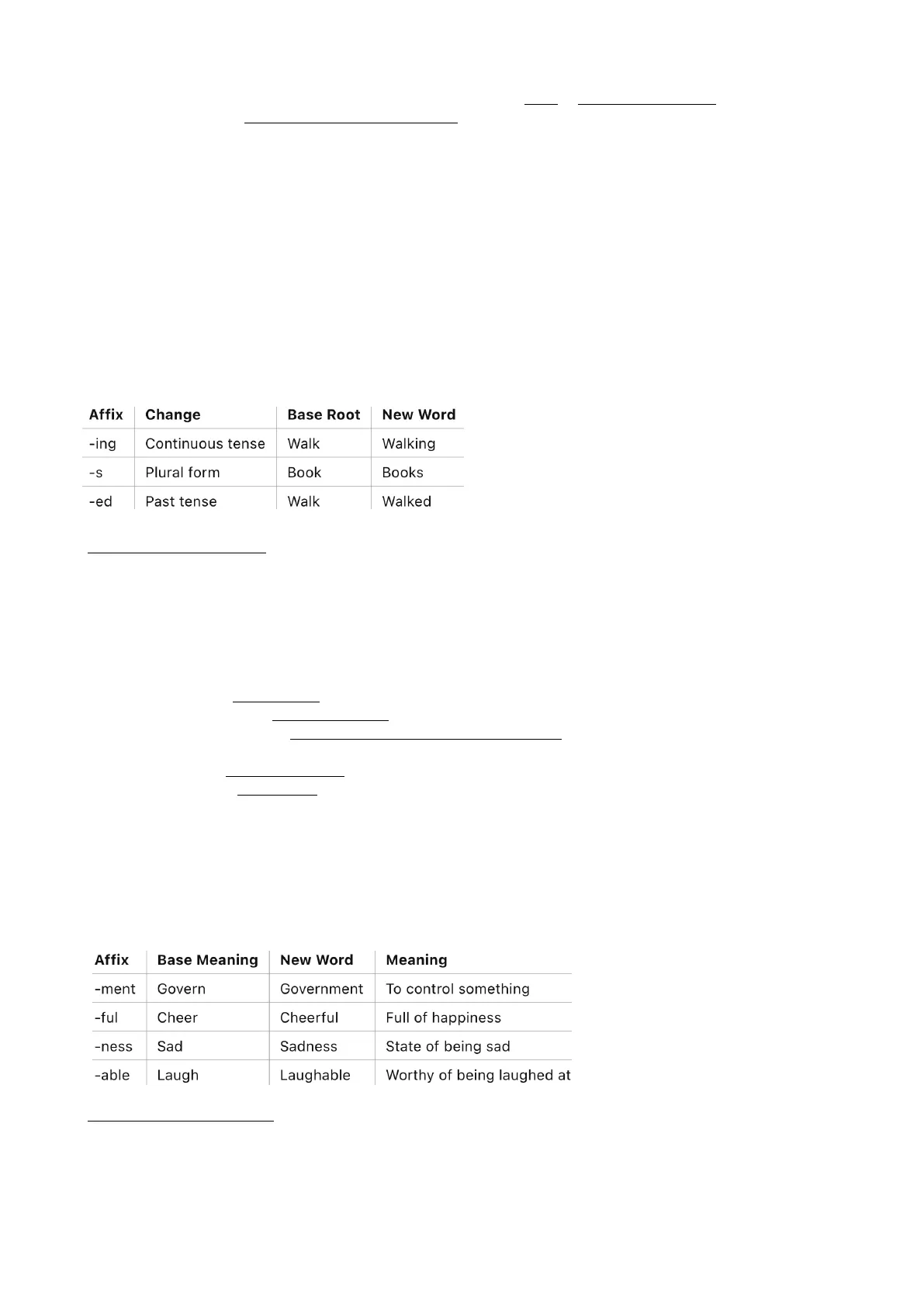Morphology, phraseology, and computational linguistics with online dictionaries
Document about morphology, phraseology, and computational linguistics with online dictionaries. The Pdf explores concepts like morphemes, allomorphs, inflectional and derivational morphology, collocations, and the challenges of online dictionaries for university-level Languages students.
Ver más12 páginas


Visualiza gratis el PDF completo
Regístrate para acceder al documento completo y transformarlo con la IA.
Vista previa
Grammar and Word Structure
GRAMMAR refers to systematic patterns both within words and within sentences. It's based on:
- Morphology's of words -> the area of grammar that studies the structure of words, that is, how morphemes combine together to form words and so how they contribute to the creation of meaning and new words;
- Syntax of sentences -> studies the structure of sentences
MORPHOLOGY is the branch of grammar that studies the structure of words and how morphemes combine together to form words.
morph -> base morph of the structure; o -> connector vowel; log -> means speech, word, account, reason; y -> suffix A word is a single unit of written/spoken language (=what we see or hear). The lexeme is the dictionary word. E.g., "friends" and "friend" are two words but one lexeme. Words consist of smaller units called morphemes. Morpheme = the smallest unit of language that combines both a meaning and/or a grammatical function (e.g., un-believ-able = 3 morphemes). - > morphemes = abstract meaningful units which combine to create words It has:
- Semantic content (ex: un- means not in unhappy)
- Grammatical function (ex: final s- indicates plural form)
Ex. the word houses: 2 morphemes: (house) + (plural). Finally, the morphemes are represented using curly braces.
- Polymorphemic (or complex) words -> more than one morpheme (e.g., friendlier - root: friend, suffix: - lier)
- Monomorphemic words -> one morpheme only (e.g., friend)
Types of Morphemes
Types of morphemes:
- Free morphemes -> can stand alone as words (prepositions/articles/possessives -s; e.g., friend). They can be divided in:
- Lexical morphemes: carry semantic meaning (noun, verb ... ) (ex. friend or book)
- Functional morphemes: carry grammatical meaning (e.g., and, but and all the w- words .. )
- Bound morphemes -> cannot occur on their own as separate words. They are generally affixes, so they are attached at the beginning or at the end of a word. There are two types:
- Derivational morphemes = affixes used for deriving new words when attached to other morphemes (e.g., -ness to creat nouns; un- to imply opposition of a meaning). They are prefixes (attached before another morpheme) or suffixes (attached after);
- Inflectional morphemes = in English they are only suffixes and express grammatical relations or functions (e.g., -s in students to indicate the plural)
It's composed of: Root = the morpheme that determines the meaning of a word, with no affixes attached to it (e.g., "happy" in "happiness"). Many roots are free morphemes, while bound roots cannot stand on their own and need to be attached to other morphemes (ex: - ceive in receive, perceive, dent- in dentist, dental). Base = the form of a word to which affixes can be attached (e.g., "happy" for "unhappy"). Morph = the concrete realization of a morpheme (ex. "Let" is a single morph that serves 2 grammatical functions: it could be both past simple or past participle; "fish" is a single morph that could function as either singular or plural;). Allomorph = variant of a morpheme; one of the different phonetic/graphic realization of a morpheme: differ in form but represent the same meaning (e.g., the plural morpheme -s in cats, dogs and horses).
- "-Ed" for the past tense which is pronounced differently in: helped, saved, added
- The realisation of the morpheme "not" through the morphs il, im. in, ir, in: immoral, intolerant, irresistible
- The indefinite article "a" has two orthographic shapes: a/an = graphic allomorph
- Allomorphs are in complementary distribution = in a specific environment we select one but not its alternative representation(s).
Examples:
- Zero morph = no visible change in form (put-put-put);
- Vowel mutation = only the vowel changes (swim-swam-swum);
- Vowel mutation + irregular inflection = change both vowels and endings (speak-spoke-spoken);
- Replace morphs = the form is entirely replaced (lose-lost-lost);
- Suppletion = a completely different form used (go-went-gone)
Irregular verbs have allomorphs, and these allomorphs are part of inflectional morphology because they show how verbs change to fit grammar rules (like past tense and participles).
Inflectional Morphology
INFLECTIONAL MORPHOLOGY = studies how words change according to the grammatical contexts, often using suffixes (e.g., adding endings like -s for plural or -ed for past tenses)
Affix Change Base Root New Word -ing Continuous tense Walk Walking -S Plural form Book Books -ed Past tense Walk Walked Inflectional morphemes -> in English they are only suffixes and express grammatical relations or functions (-s to indicate plural). Possession: In english, nouns inflect also for the possessive case by adding the inflectional suffix 's, which expresses the genitive case. Irregular verbs:
- Hurt-hurt-hurt = zero morph (no visible change in form);
- Swim-swam-swum = vowel mutation (only the vowel changes);
- Speak-spoke-spoken = vowel mutation + irregular inflection (changes to both vowels and endings);
- lose-lost-lost = replace morphs (the form is entirely replaced);
- Go-went-gone = suppletion (a completely different form used)
NB it is important for regular verbs ending in -ed (e.g., "cooked") and irregular verbs with the same form for each time tenses (e.g., "hit"), to indicate all possible grammatical functions, because the professor does not give you the context.
Derivational Morphology
DERIVATIONAL MORPHOLOGY = studies how words change to create new words by adding affixes (prefixes or suffixes) (e.g., happiness from happy + -ness)
Affix Base Meaning New Word Meaning -ment Govern Government To control something -ful Cheer Cheerful Full of happiness -ness Sad Sadness State of being sad -able Laugh Laughable Worthy of being laughed at Derivational morphemes -> affxes used for deriving new words when attached to other morphemes (-ness to create nouns, un- to imply opposition of meaning ... ). They are tools for lexical productivity. Examples:
- Brighter -> 2 morphs. bright-er, 2 morphemes (bright)+(comparative) 2
- Studying -> 2 morphs study-ing, 2 morphemes (to study)+(progressive or continuous)
- Cooked -> 2 morphs cook-ed, 2 morphemes (to cook)+(past simple/participle)
Word Formation Processes
WORD FORMATION PROCESSES Word families = group of words that share the same root/base form but differ in their affixes or inflections. They are related in meaning (e.g., nation, nationality, nationalism, international ... ). Compounding -> combination of 2 or more free morphemes to create a lexeme with a new meaning (e.g., "made in Italy", "green tea"). Any combination of parts of the speech is possible (ex: pass in password, web in website, business in business school). It can be between:
- adjective + noun (green tea)
- adjective + adjective (bitter-sweet)
- noun + adjective (user-friendly)
- verb + noun (checklist)
- verb + verb (stir-fry)
Types of Compounds
Types of compounds:
- Endocentric compounds -> internal reference, so the meaning is clear from one part (e.g., bedroom -> bed is the reference);
- Exocentric compounds -> external reference, so the meaning is not obvious and you need to know the context (e.g., paperback).
- Copulative compounds -> the morphemes are on the same level and they both contribute to the meaning of the word (e.g., African-American)
NB: phrasal verbs are not compounds. They behave like phrases Affixation -> adding prefixes or suffixes
- Prefixes are class-maintaining and affect meaning (e.g., disappear, intercultural)
- Most suffixes are class-changing (e.g., sad -> sadly)
Conversion or Zero Derivation -> the process of changing the class of a word without any change of form (e.g., google -> to google) Backformation -> the creation of a base form from a derived word, by removing affixes (e.g., editor -> to edit)
Processes of Shortening Words
PROCESSES OF SHORTENING WORDS (Acronyms, initialism, clipping)
- Acronyms -> abbreviations pronounced as words (NATO);
- Initialisms -> abbreviations pronounced as letters (am-pm).
- Clipping -> process of the cutting off parts of a word (the beginning, the end or both). The result are clipped words (e.g., professor -> prof; refrigerator -> fridge)
- Blending -> process of fusing two words (e.g., breakfast + lunch= brunch)
- Borrowing -> adopting a foreign word (e.g., ninja). Maintaining or not the spelling and the pronunciation
- Coinage -> process of creating a completely new word. Typically involves inventing terms for new products/concepts (e.g., google, zoom, bitcoin .. )
- Reduplication -> process of repeating parts of a word for effect. In English it is often used in children's language (e.g. boo-boo, goody-goody). There are 3 different kinds of reduplication:
- Exact reduplication (e.g., mama, papa, goody-goody, so-so);
- Ablaut reduplication: the vowel changes while the consonants remain the same (e.g criss- cross, zig-zag, flip-flop);
- Rhyme reduplication: the consonants change while the vowel remains the same (e.g., hodge- podge, fuddy-duddy)
SEMANTIC CHANGE OR SHIFT = is the change of meaning of existing lexemes: the old meaning stays there, but there is a replacement of new meanings (ex. mail comes from letters, but now it is associated with electronic mail).
Word Formation Issues
WORD FORMATION ISSUES 3- Ly can be both inflectional and derivational.
- As an inflectional suffix, it modifies many adjectives to form adverbs (e.g., quick -> quickly, sad -> sadly)
- As derivational suffix, it changes the word's class and creates new meanings (e.g., friend -> friendly, an adjective from "friend")
Compounds vs. Phrasal Verbs
Compounds vs phrasal verbs Sometimes, in English phrasal verbs can be confused with compounds, but they are not compounds, and behave like phrases.
- In terms of semantics, phrasal verbs combine a verb and a particle to create a new verb with an idiomatic meaning (e.g., "burn down" = distruggere), whereas compounds combine 2 words with more literal meanings (e.g., "white-house" = casa bianca);
- In terms of internal modification, phrasal verbs are flexible and allow the particle to move (e.g., "burned the house down"), whereas compounds are fixed and cannot be split.
- In terms of stress, in phrasal verbs the stress is on the particle (e.g., "burn down"), whereas in compounds it is on the first word (e.g., "white-house").
Idioms
IDIOMS Idiom = sequence of words that functions as a single unit. It is:
- Syntactically fixed -> its structure doesn't change;
- Semantically conventionalized -> it's meaning isn't directly derived from the literal meanings of the individual words
GRAMMAR = the set of patterns and rules for forming sentences, phrases and clauses with words. There is:
- Spoken grammar (with repetitions and hesitations)
- Written grammar.
There are
- Lexical morphemes: are about word formation processes
- Grammatical morphemes express grammatical notions
Grammatical Categories
GRAMMATICAL CATEGORIES are linguistic features expressed by grammatical morphemes, defining the grammatical roles of words in a sentence. In English we have different grammatical categories: Nominal categories: these apply to nouns, adjectives and adverbs. Express specific grammatical information:
- Number -> singular or plural;
- Gender -> masculine, feminine or neutre (common gender = you, we, they .. );
- Person -> first, second, third;
- Case -> indicates the function of a noun phrase and is expressed in pronouns: subject (nominative: I, you, we .. ), object (objective: me, us you .. ), possession (genitive: my/mine, your .. ).
- Degree (positive, comparative or superlative).
Types of Genitives
Types of genitives:
- Possessive genitive = shows ownership (John's book)
- Subjective genitive = it's the subject of the action (the teacher's explanation -> the teacher explains)
- Objective genitive = is the object of the action (the city's destruction -> someone destroys the city)
- Genitive of origin = expresses the source of origin (A story of Rome)
- Descriptive genitive = describe a quality (man of wisdom -> wise man).
- Partitive genitive = express a part of a whole (a piece of cake)
Verbal categories: express the grammatical context of an action/state: 4